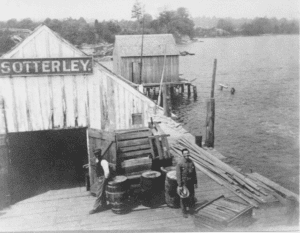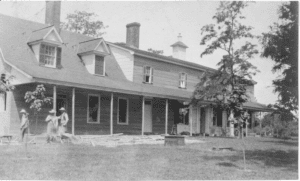Sotterley's History

Archival Photo of Sotterley Wharf
When James Bowles had a cypress post sunk into the ground in 1703 to begin construction of a two-room home on the shore of the Patuxent River in Southern Maryland, he couldn't have known that he was on the first page of a long, rich, American story.
Bowles, a plantation owner, merchant, and slave trader, was Sotterley Plantation's first owner; Mabel Ingalls, a bacteriologist, its last. In the nearly 300 years that separated his first year as an owner and her last came a fascinating line of individuals who presided over Sotterley. They included one of the wealthiest women in the Maryland colony; a governor; a physician who ran a boarding school at Sotterley, and a former assistant secretary of the U.S. Navy and his wife, the daughter of one of the nation's most powerful financiers.
Supporting the ambition of these American aristocrats from Sotterley's beginning until the mid-19th century was a community of enslaved persons whose talents and labor developed Sotterley into one of the largest plantations in the Tidewater region.
Sotterley's location in the Patuxent gave its 18th and 19th century owners access to the valuable shipping lanes of the Chesapeake Bay and the Atlantic Ocean. Tobacco was a key export, as were corn and lumber. Many ships brought luxury goods from Europe to Sotterley's wharf. Others delivered captive Africans. Still other ships brought letters from Americans whose names fill our history books.
Sotterley was its own, self-contained world for most of its history. During the colonial era, plantation owners resisted the formation of towns, preferring to govern their property and those who lived on it without interference from local authorities. Sotterley's owners were active politically and enjoyed privileges of the well-connected. But there was tension between the growing wealth of Sotterley's 18th and 19th century owners and the way that wealth was created and sustained. The harshness of chattel slavery prompted the enslaved to resist and some to take their freedom. During a British raid during the War of 1812, nearly 50 enslaved people escaped, disrupting the plantation's economy. Maryland outlawed slavery in 1864, and the Federal government did so the following year. With that, the plantation system collapsed, taking the fortunes of Sotterleys' owners with it.

Archival photo of renovations to the Manor House during the Herbert Satterlee era.
But Sotterley survived. In 1910, during what is now known as the Colonial Revival movement, the rundown property was purchased by New York attorney Herbert Satterlee. Herbert, with his wife, Louisa, embarked on a plan to restore the Manor House, outbuildings, and farming operations to his vision of the 18th century. Sotterley bloomed again, with beautiful gardens and productive fields. Sotterley became a museum by 1961. Since then, it has been guided by a Board of Trustees and operated by a small staff with the help of dedicated volunteers. They continue to care for this magnificent National Historic Landmark and its educational and cultural programs.
James Bowles acquires land and builds a two-room house.
A ship delivers enslaved Africans to Royal African Company agent James Bowles. Another room is added to the house.
Rebecca and George Plater II enlarge the house, adding a dining room.
George Plater III raises the house to a full two stories.
The Declaration of Independence is signed. The plantation becomes known as Sotterley.
Sotterley is plundered by British forces. Slaves escape with the British.
George Plater III becomes Maryland governor. Sotterley's slave community numbers 90.
British troops destroy Sotterley's tobacco crop and help slaves escape.
Sotterley changes hands three times. Emeline and Walter Briscoe inherit 400 acres and the house.
Sotterley's surviving Slave Cabin is constructed. Walter and Emeline Briscoe open a boarding school.
Hilry Cane, an enslaved man and a skilled plasterer, comes to live at Sotterley with his family, which eventually includes 18 children.
Civil War begins. Briscoe sons and George Washington Barnes serve on opposite sides.
Maryland constitutional amendment outlaws slavery.
Walker Briscoe requests government compensation for emancipated slaves.
The Cane family moves away from Sotterley.
Rev. James Briscoe purchases Sotterley after the estate is put up for auction.
Rev. Briscoe's daughter, Elizabeth, and her husband, J. Douglas Cashner, acquire full ownership of Sotterley.
New York lawyer Herbert Satterlee purchases and rehabilitates Sotterley and hires Charles Knott as Farm Manager.
Bacteriologist Mabel Satterlee Ingalls purchases Sotterley from her father's estate.
Mabel Ingalls starts a nonprofit foundation and Sotterley opens as a museum.
Descendant Agnes Kane Callum joins the Board of Trustees.
Mabel Ingalls passes; the foundation assumes ownership.
Sotterley is designated as a National Historic Landmark.
Designated as Middle Port Markers Site.
Agnes Kane Callum passes.
Slave Cabin exhibit dedicated to Agnes Kane Callum.
Sotterley designated as a UNESCO Site of Memory for the Routes of the Enslaved Peoples. First UNESCO International Day for the Remembrance of the Slave Trade and its Abolition.
